1.多路选择器
module MUX41a(a,b,c,d,s1,s0,y);
input a,b,c,d;
input s1,s0;
output y;
reg y;
always @(a or b or c or d or s1 or s0)
begin : MUX41
case({s1,s0})
2'b00 : y<=a;
2'b01 : y<=b;
2'b10 : y<=c;
2'b11 : y<=d;
default : y<=a;
endcase
end
endmodule
2.4X4路交叉开关
module jiaochakaiguan
(
IN0,
IN1,
IN2,
IN3,
SEL0,
SEL1,
SEL2,
SEL3,
OUT0,
OUT1,
);
parameter WL = 16;
input [WL-1 : 0] IN0, IN1, IN2, IN3;
input SEL1, SEL0, SEL2, SEL3;
output [WL-1 : 0] OUT0, OUT1;
reg [WL-1 : 0] OUT0, OUT1;
always @ (IN0 or IN1 or IN2 or IN3 or SEL0 or SEL1)
begin
case ({SEL0, SEL1})
2'b00 : OUT0 = IN0;
2'b01 : OUT0 = IN1;
2'b10 : OUT0 = IN2;
2'b11 : OUT0 = IN3;
endcase
end
always @ (IN0 or IN1 or IN2 or IN3 or SEL2 or SEL3)
begin
case ({SEL2, SEL3})
2'b00 : OUT1 = IN0;
2'b01 : OUT1 = IN1;
2'b10 : OUT1 = IN2;
2'b11 : OUT1 = IN3;
endcase
end
endmodule
3.8输入的优先编码器
// module top, 4 input priority encoder with zero input check
module ecoder(
IN , // input
OUT ); // output
input [7:0] IN;
output[2:0] OUT;
reg [2:0] OUT;
// get the OUT
always @ (IN) begin
if(IN[7]) // 第一优先
OUT = 3'b111;
else if(IN[6]) // 第二优先
OUT = 3'b110;
else if(IN[5]) // 第三优先
OUT = 3'b101;
else if(IN[4]) // 第四优先
OUT = 3'b100;
else if(IN[3]) // 第第五优先
OUT = 3'b011;
else if(IN[2]) // 第六优先
OUT = 3'b010;
else if(IN[1]) // 第七优先
OUT = 3'b001;
else if(IN[0]) // 第八优先
OUT = 3'b000;
end
endmodule
4.4-16的译码器
// module top, 4 input priority encoder with zero input check
module ecoder(
IN , // input
OUT ); // output
input [3:0] IN;
output[15:0] OUT;
reg [15:0] OUT;
// get the OUT
always @ (IN) begin
case(IN)
4'b0000: OUT = 16'b0000_0000_0000_0001;
4'b0001: OUT = 16'b0000_0000_0000_0010;
4'b0010: OUT = 16'b0000_0000_0000_0100;
4'b0011: OUT = 16'b0000_0000_0000_1000;
4'b0100: OUT = 16'b0000_0000_0001_0000;
4'b0101: OUT = 16'b0000_0000_0010_0000;
4'b0110: OUT = 16'b0000_0000_0100_0000;
4'b0111: OUT = 16'b0000_0000_1000_0000;
4'b1000: OUT = 16'b0000_0001_0000_0000;
4'b1001: OUT = 16'b0000_0010_0000_0000;
4'b1010: OUT = 16'b0000_0100_0000_0000;
4'b1011: OUT = 16'b0000_1000_0000_0000;
4'b1100: OUT = 16'b0001_0000_0000_0000;
4'b1101: OUT = 16'b0010_0000_0000_0000;
4'b1110: OUT = 16'b0100_0000_0000_0000;
4'b1111: OUT = 16'b1000_0000_0000_0000;
// full case 不需要写default,否则一定要有default
endcase
end
endmodule
5.无符号加法器
module top(
IN1 ,
IN2 ,
OUT );
input[3:0] IN1, IN2;
output[4:0] OUT;
reg[4:0] OUT;
always@(IN1 or IN2) begin // 生成组合逻辑的always 块
OUT = IN1 + IN2;
end
endmodule
6.补码加法器
module bumaaad(
IN1,
IN2,
OUT
);
input signed [3:0] IN1,IN2;
output signed [4:0] OUT;
reg signed [4:0] OUT;
always@(IN1 or IN2) begin
OUT=IN1+IN2;
end
endmodule
7.带两级流水线的加法器
module wateradd(
IN1,
IN2,
CLK,
OUT
);
input [8:0] IN1,IN2;
input CLK;
output [4:0] OUT;
reg [3:0] in1_d1R,in2_d1R,in3_d1R,in4_d1R;
reg [4:0] addr_out ,OUT;
always@(posedge CLK) begin
in1_d1R<=IN1;
in2_d1R=IN2;
end
always@(posedge CLK) begin
in3_d1R<=in1_d1R;
in4_d1R<=in2_d1R;
OUT <=addr_out;
end
always@(in1_d1R or in2_d1R)begin
addr_out=in3_d1R+in4_d1R;
end
endmodule
8.两级流水线加法器RTL结构图
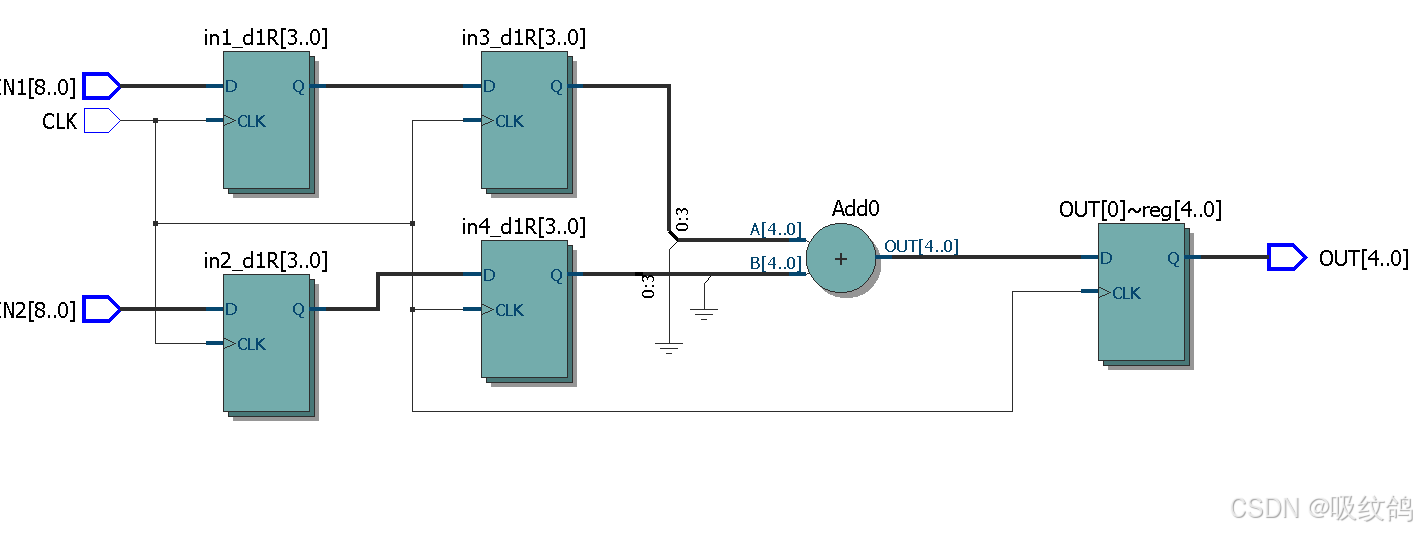
9.无符号乘法器
module usignmux(
IN1,
IN2,
OUT
);
input[3:0] IN1,IN2;
output[4:0] OUT;
reg [4:0] OUT;
always@(IN1 or IN2) begin
OUT=IN1+IN2;
end
endmodule
10.有符号乘法器
module mux(
IN1,
IN2,
OUT
);
input signed[3:0] IN1,IN2;
output signed[7:0] OUT;
reg signed[7:0] OUT;
always@ (IN1 or IN2)begin
OUT=IN1*IN2;
end
endmodule
11.输入和输出都带有流水线的无符号乘法器
module mux(
IN1,
IN2,
OUT,
CLK
);
input [3:0] IN1,IN2;
input CLK;
output [7:0] OUT;
reg [3:0] in1_d1R,in2_d1R;
reg [7:0] mux_out,OUT;
always@ (posedge CLK)begin
in1_d1R <= IN1;
in2_d1R <= IN2;
OUT <= mux_out;
end
always@ (IN1 or IN2)begin
mux_out=in1_d1R*in2_d1R;
end
endmodule
RTL视图如下
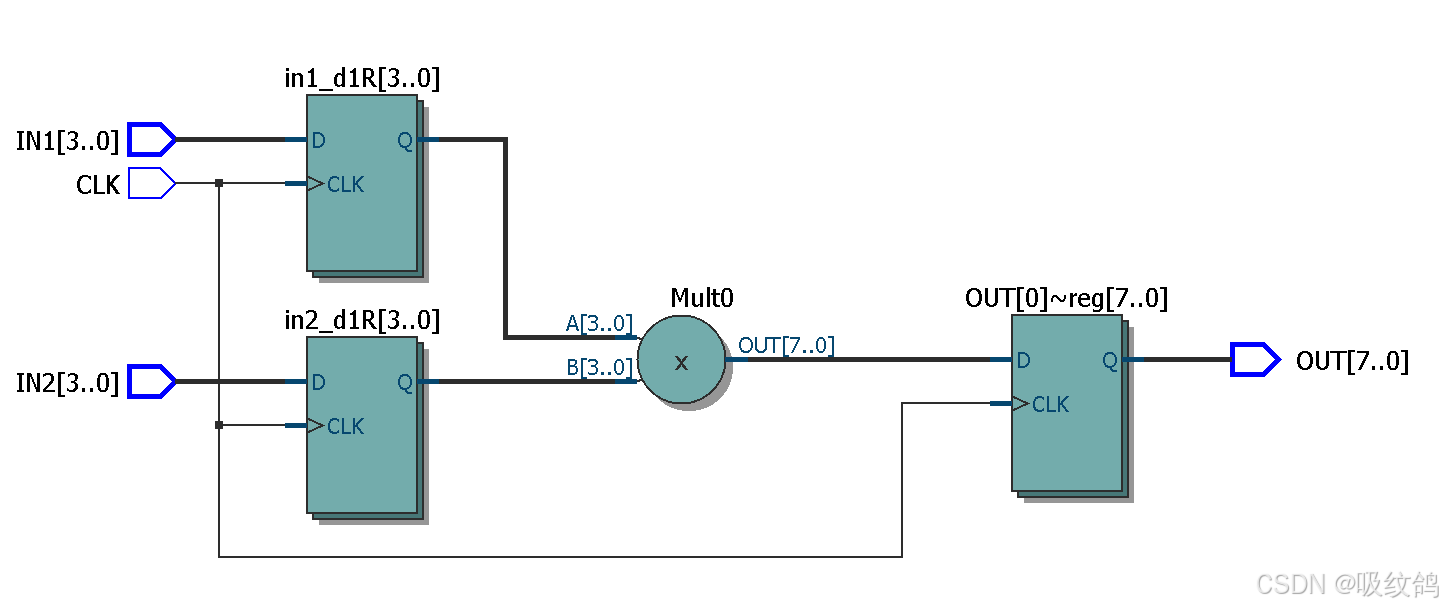
12.有符号的8位乘法器
//8wei mul
module chengfaqi
(
IN1,
IN2,
OUT
);
input signed [7 : 0] IN1, IN2;
output signed [15 : 0] OUT;
reg signed [15 : 0] OUT;
always @ (IN1 or IN2)
begin
OUT = IN1 * IN2;
end
endmodule
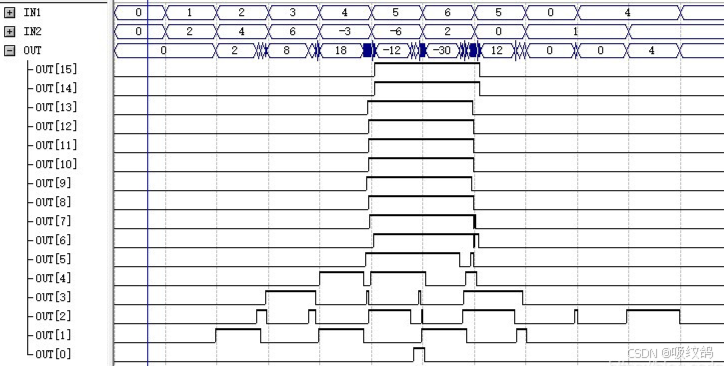
13.有流水线的8位乘法器
//8wei D mul
module chengfaqi
(
IN1,
IN2,
CLK,
OUT
);
input signed [7 : 0] IN1, IN2;
input CLK;
output signed [15 : 0] OUT;
reg signed [15 : 0] OUT, mul_out;
reg signed [7 : 0] in1_d1R, in2_d1R;
always @ (posedge CLK)
begin
in1_d1R <= IN1;
in2_d1R <= IN2;
OUT <= mul_out;
end
always @ (in1_d1R or in2_d1R)
begin
mul_out = in1_d1R * in2_d1R;
end
endmodule
仿真结果
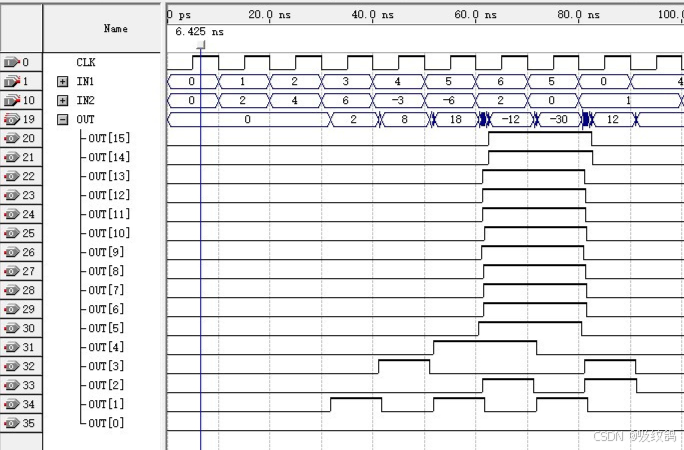
通过比较八位带D触发器与不带D触发器的波形仿真图,可以观察到毛刺减少。
14.计数器
设计复杂的计数器,带有多种信号,其中同步清零CLR的优先级最高,使能EN次之,LOAD最低
module cnt(
RST,
CLK,
EN,
CLR,
LOAD,
DATA,
CNTVAL,
OV
);
input RST,CLK ,EN,CLR,LOAD ;
input [3:0] DATA ;
output [3:0]CNTVAL;
output OV;
reg [3:0] CNTVAL,cnt_next;
reg OV;
parameter CNT_MAX_VAL=9;
always @(EN or CLR or LOAD or DATA or CNTVAL)begin
if(CLR) begin // 清零有效
cnt_next = 0;
end
else begin //清零无效
if(EN) begin // 使能有效
if(CNTVAL < CNT_MAX_VAL) begin // 未计数到最大值, 下一值加1
cnt_next = CNTVAL + 1'b1;
end
else begin // 计数到最大值,下一计数值为0
cnt_next = 0;
end
end
else begin //使能无效
if(LOAD) begin // 加载有效
cnt_next = DATA;
end
else begin
cnt_next=CNTVAL;
end
end
end
end
always @ (posedge CLK or posedge RST )begin
if(RST )
CNTVAL<=0;
else
CNTVAL<=cnt_next;
end
always @ (CNTVAL)begin
if(CNTVAL==CNT_MAX_VAL)
OV = 1;
else
OV = 0;
end
endmodule
- 设计一个最简单的计数器,只有一个CLK输入和一个OVerflow输出,当计数到最大值的时钟周期CLK输出1,代码如下
-
module cnt( CLK, OVerflow ); input CLK; output OVerflow=0; reg OVerflow; reg [3:0] cnt_next=0; parameter CNT_MAX_VAL = 9; always @(posedge CLK)begin if(cnt_next<CNT_MAX_VAL-1)begin cnt_next<=cnt_next+1'b1; end else begin OVerflow<=1; cnt_next<=0; end end endmodule15.状态机
-
设计一个用于识别2进制序列“1011”的状态机
- 基本要求:
- 电路每个时钟周期输入1比特数据,当捕获到1011的时钟周期,电路输出1,否则输出0
- 使用序列101011010作为输出的测试序列
- 扩展要求:
- 给你的电路添加输入使能端口,只有输入使能EN为1的时钟周期,才从输入的数据端口向内部获取1比特序列数据。
-
module ztj( CLK , RST , IN , EN , OUT , ); input CLK ; input RST ; input EN ; input IN; output OUT; parameter ST0=0; parameter ST1=1; parameter ST2=2; parameter ST3=3; parameter ST4=4; reg [2:0]stateR; reg [2:0]next_state; reg OUT; always @(IN or EN or stateR) begin case (stateR) ST0: begin if(EN==1&&IN==1) next_state=ST1; else next_state=ST0; end ST1:begin if(EN==1&&IN==0) next_state=ST2; else if(EN==1&&IN==1) next_state=ST1; else next_state=ST0; end ST2:begin if(EN==1&&IN==1) next_state=ST3; else next_state=ST0; end ST3:begin if(EN==1&&IN==1) next_state=ST4; else if(EN==1&&IN==0) next_state=ST2; else next_state=ST0; end ST4:begin if(EN==1&&IN==1) next_state=ST1; else next_state=ST0; end endcase end always @(stateR)begin if(stateR==ST4) OUT=1'b1; else OUT=1'b0; end always @(posedge CLK or posedge RST)begin if(RST) stateR<=ST0; else stateR<= next_state; end endmoduleRTL中的状态转移图
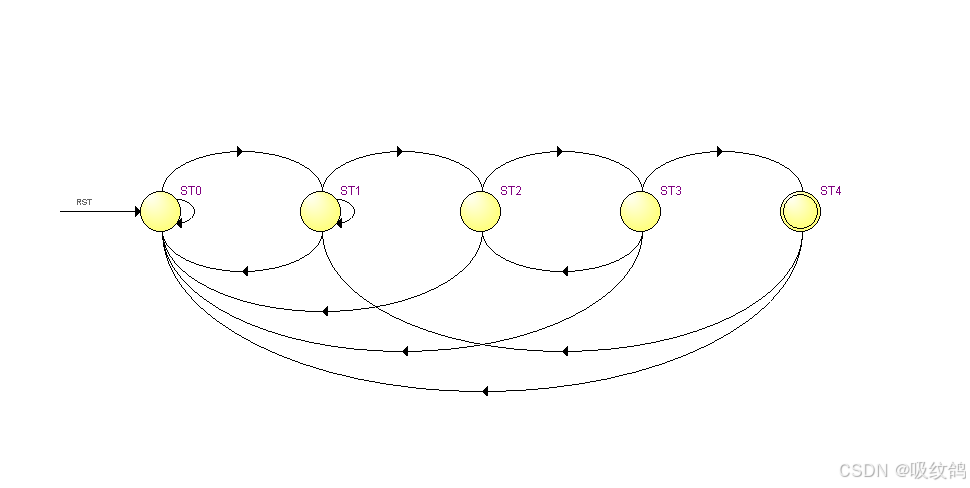
-
16.带加载使能和移位使能的并入串出”的移位寄存器
-
module sr( RST, CLK, LOAD, EN, IN, OUT ); input RST,CLK,EN,LOAD; input [3:0]IN; output OUT; reg [3:0] shift_R; reg OUT; always @ (posedge CLK or posedge RST or posedge LOAD)begin if(RST) shift_R <=0; else begin if(LOAD)begin shift_R[3:0] <= IN[3:0]; end else begin if(EN) begin shift_R[3:1] <= shift_R[2:0]; shift_R[0] <= 0; OUT = shift_R[3]; end else begin shift_R[3:0]<=shift_R[3:0]; end end end end endmodule
双口RAM
module dpram
(
WE,
WCLK,
RCLK,
WA,
RA,
WD,
RD
);
parameter DATAWL = 0;
parameter ADDRWL = 0;
parameter C2Q = 0;
input WE, WCLK, RCLK;
input [ADDRWL-1 : 0] WA, RA;
input [DATAWL-1 : 0] WD;
output [DATAWL-1 : 0] RD;
reg [DATAWL-1 : 0] RD;
reg [DATAWL-1 : 0] mem [(1<<ADDRWL)-1 : 0]; ///????
always @ (posedge WCLK)
begin
if(WE)
mem[WA] <= #C2Q WD;//????
end
always @ (posedge RCLK)
begin
RD <= #C2Q mem[RA];
end
// ######################################
// synopsys translate_off
// ######################################
// the code below this line will NOT take part into synthesis
// they are only needed by RTL simulation
// task DumpDpRAM, get the content of RAM[addr]
task DumpDpRAM;
input [ADDRWL-1 : 0] addr;
input [DATAWL-1 : 0] content;
begin
content = mem[addr];
end
endtask
task RAMInit;
integer i;
reg [DATAWL-1 : 0] initData;
begin
initData = ‘hAAAA;
//initData = (1<<DATAWL) - 1;
for(i = 0; i << (1 << ADDRWL); i = i + 1)
mem[i] = initData;
end
endtask
initial
begin
RAMInit();
$display("module dpram().RAMInit()called @ %0d", $time);
end
// ######################################
// synopsys translate_on
// ######################################
// the code below this line will take part in synthesis
endmodule
17.ROM
module ROM
(
CLK,
RA,
RD
);
input CLK;
input [6 : 0] RA;
output [12 : 0] RD;
reg [12 : 0] RD;
always @ (posedge CLK)
case(RA)
7'd0 : RD = #1 13'd 0;
7'd1 : RD = #1 13'd 101;
7'd2 : RD = #1 13'd 201;
7'd3 : RD = #1 13'd 301;
... ... ...
7'd127 : RD = #1 13'd 8190;
endcase
endmodule
18.寄存器组和多重例化
// module top, example for, 'for' and 'generate'
module top(
CLK ,
RST ,
IN1 ,
OUT1 );
parameter DWL = 8;
parameter reg_len = 3;
input CLK;
input RST;
input [DWL-1:0] IN1;
output [DWL-1:0] OUT1;
reg [DWL-1:0] in1R[reg_len-1:0];
wire [DWL-1:0] in1R_inW[reg_len-1:0];
integer idx;
always @ (posedge CLK or posedge RST) begin
if(RST) begin
for(idx = 0; idx < reg_len; idx = idx +1) begin
in1R[idx] <= 0;
end
end
else begin
for(idx = 0; idx < reg_len; idx = idx +1) begin
in1R[idx] <= in1R_inW[idx];
end
end
end
genvar i_g;
generate
for (i_g =0; i_g < reg_len; i_g=i_g+1) begin: MULT_INST
wire [DWL-1:0] logic_inW;
if(i_g == 0) begin
assign logic_inW = IN1;
end
else begin
assign logic_inW = in1R[i_g-1];
end
param_logic U_pl(
.IN (logic_inW ),
.OUT (in1R_inW[i_g] ));
defparam U_pl.DWL = DWL;
defparam U_pl.INST_P1 = i_g;
end
endgenerate
assign OUT1 = in1R[reg_len-1];
endmodule
module param_logic(
IN ,
OUT );
parameter DWL = 0;
parameter INST_P1 = 0;
input [DWL-1:0] IN ;
output [DWL-1:0] OUT ;
assign OUT = IN + INST_P1;
endmodule
作者水平有限,如有错误请在评论区指出。




















 1393
1393

 被折叠的 条评论
为什么被折叠?
被折叠的 条评论
为什么被折叠?








